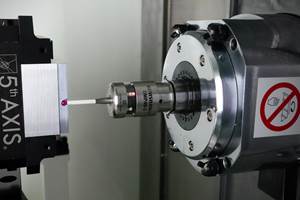Never Forget The Basics
We spend a lot of time in this column discussing sophisticated gages and out-of-the-ordinary applications—so much so, that perhaps we've lately been neglecting the basics. After all, the fanciest electronics, computers and software won't deliver accurate results if good gaging practice is absent.
We spend a lot of time in this column discussing sophisticated gages and out-of-the-ordinary applications—so much so, that perhaps we've lately been neglecting the basics. After all, the fanciest electronics, computers and software won't deliver accurate results if good gaging practice is absent. So let's review a couple of the bedrock principles that apply to virtually every precision measurement situation: proper gage specification and inspection, care and maintenance.
First, there's the "ten to one" rule. The measuring instrument should resolve to approximately one-tenth of the tolerance being measured. For example, if the total tolerance spread is 0.01 mm (that is, ±0.005 mm), the smallest increment displayed on the gage should be 0.001 mm. A gage that only reads to 0.005 mm can't resolve closely enough for accurate judgments in borderline cases, and doesn't allow for the observation of trends within the tolerance band. On the other hand, a gage that resolves to 0.0001 mm might give the user the impression of excessive part variation, and requires more care to read and record results. It also might not have adequate range, and would certainly cost more than necessary for the application. For some extremely tight tolerance applications (say, ±50 microinches or less), 10:1 is not readily achievable, and it may be necessary to accept 5:1. For coarse work, 10:1, or something very close to it, should always be used.
All measuring tools should be inspected at least once a year for calibration and repeatability. Tools that are used for critical measurements, or that are subjected to unusually hard or frequent use, should be inspected more frequently—possibly as often as every three months. If a gage is dropped, don't take a chance; get it checked right away. Even though it appears to work properly, accuracy or repeatability may have been affected. The cost of having it inspected and calibrated is usually trivial compared to the cost of relying on bad measurements. What may those be? Scrap, rework, returns—possibly even legal liability.
Certification is the process of verifying that a measuring tool meets original-equipment specifications by checking its performance against a standard that is traceable to a national reference standard. Certification thus represents a higher level of assurance than a normal inspection, which may be performed using gages and standards that are believed to be accurate, but are not themselves certified and traceable. Annual certification of all precision measuring instruments should be a requirement in any shop that prides itself on accurate and/or close-tolerance work, and it must be done in shops working to achieve or maintain ISO/QS 9000 certification.
Poor gage repeatability has many possible causes, which can generally be summarized as parts or components that are loose, bent, worn or sticking. Gage contacts or anvils are probably the most common source of problems because they're in direct contact with the workpiece and exposed to damage. They should be visually inspected frequently for chips, scratches, and visible signs of wear, and checked periodically for parallelism and flatness as well.
Most handheld measuring instruments are sold with a fitted box. Use it. Don't put loose gages in a toolbox, alongside old drill bits, screwdrivers, and assorted chips and grime. Keep your gages clean, and treat them with care and respect. Any time you see a gage that looks beat up—it probably has been. Don't trust it, unless you first prove its capabilities through inspection, calibration, and certification.
We occasionally see shops that pay their machinists well and spend hundreds of thousands of dollars on new production equipment, but use old gages, micrometers, and verniers with problems so severe that they won't repeat to within several divisions on the indicator dial or barrel scale. That's penny wise and pound foolish. Regular gage inspection and certification is a clear sign to customers that you take pride in your work, that you're making proper efforts to eliminate bad parts, and that you're seriously committed to quality.
Related Content
Ballbar Testing Benefits Low-Volume Manufacturing
Thanks to ballbar testing with a Renishaw QC20-W, the Autodesk Technology Centers now have more confidence in their machine tools.
Read MoreWhat Should Machinists Know About In-Machine Probing?
In-machine probing doesn’t reach the power of CMMs but can still be useful for pre- and mid-process control, as well as for “rough screening” of parts.
Read More4 Ways to Establish Machine Accuracy
Understanding all the things that contribute to a machine’s full potential accuracy will inform what to prioritize when fine-tuning the machine.
Read MoreDetermining Out-of-Roundness at the Point of Manufacture
George Schuetz, Mahr Inc.’s Director of Precision Gages, offers these techniques for measuring roundness on the shop floor.
Read MoreRead Next
3 Mistakes That Cause CNC Programs to Fail
Despite enhancements to manufacturing technology, there are still issues today that can cause programs to fail. These failures can cause lost time, scrapped parts, damaged machines and even injured operators.
Read MoreThe Cut Scene: The Finer Details of Large-Format Machining
Small details and features can have an outsized impact on large parts, such as Barbco’s collapsible utility drill head.
Read More












.png;maxWidth=300;quality=90)










